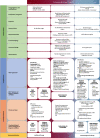Hypersensitivity Pneumonitis: Challenges of a Complex Disease
- PMID: 38283656
- PMCID: PMC10810695
- DOI: 10.1155/2024/4919951
Hypersensitivity Pneumonitis: Challenges of a Complex Disease
Abstract
Hypersensitivity pneumonitis (HP) is a complex interstitial lung disease caused by chronic inhalation of a wide variety of antigens in susceptible and sensitized individuals, commonly associated with an occupational exposure. An impressive number of inciting antigens causing hypersensitivity pneumonitis have been found to cover a wide range of occupations. As working practices have changed over time, especially in industrialized countries, new names for occupational HP have emerged. This review emphasizes the main diagnostic issues arising from the high variability of clinical presentation and the broad spectrum of causal antigens. Furthermore, it provides an overview of current methods to unveil possible causes of hypersensitivity pneumonitis, highlights HP's current diagnostic and treatment challenges and the remaining areas of uncertainty, and presents prevention strategies.
Copyright © 2024 Diana Calaras et al.
Conflict of interest statement
Authors Diana Calaras, Aliona David, Eirini Vasarmidi, and Alexandru Corlateanu declare no conflicts of interest related to the submitted work. Author Katerina Antoniou declares honoraria from Boehringer Ingelheim, Hoffmann La Roche, Chiesi, Astra-Zeneca, and GSK and research grants from Boehringer Ingelheim and Hoffmann La Roche.
Figures


References
-
- Campbell J. M. Acute symptoms following work with hay. BMJ . 1932;2:1143–1144.
Publication types
MeSH terms
Substances
LinkOut - more resources
Full Text Sources
Medical
Research Materials
Miscellaneous

